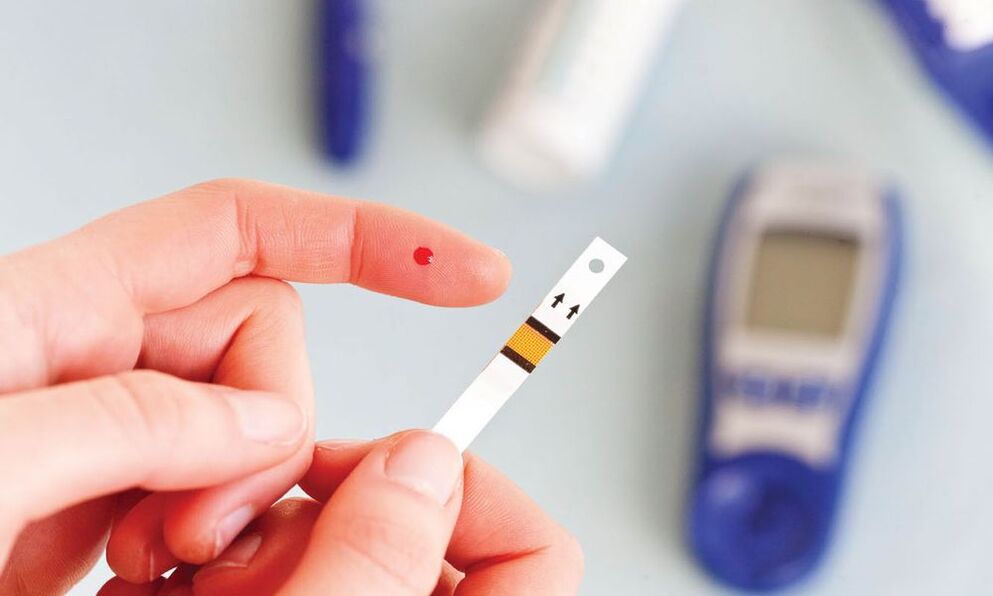
You can determine diabetes by paying attention to the symptoms that appear. With this endocrine disease, the health condition worsens. In the beginning, many patients do not even pay attention to the first symptoms of diabetes mellitus, although with type I pathology they reduce the quality of human life in a few days. The later the disease is detected, the more difficult it is to achieve its compensation. Remember the signs of diabetes, this will allow you to consult a doctor in a timely manner if they appear.
Characteristics of the disease
Diabetes mellitus is a serious endocrine pathology in which there is an absolute or relative insufficiency of insulin. In the first case, the cells of the pancreas do not produce it in the necessary quantities, and in the second case, it disrupts the process of interaction of this hormone with the target cells.
Insulin is necessary so that the glucose entering the body can be absorbed by the tissues. If the hormone does not perform its functions, sugar circulates in the blood for a long time. As a result, tissues and organs do not receive the necessary energy.

The pathology is manifested by the development of permanent hyperglycemia. Sugar concentration is constantly above the norm. In this disease, all types of metabolism are disturbed. Problems arise due to the metabolism of carbohydrates, fats, water and salt, proteins and minerals.
Classification
Endocrinologists distinguish the following types of diabetes:
- insulin dependent (type I);
- non-insulin dependent (type II);
- gestational.
Type I diabetes is insulin dependent. This form of the disease is detected mainly in children and young people. The main symptoms of type I pathology are pronounced. In this form of the disease, insulin is not produced in the patient's body, so patients need to inject this hormone daily.
In form II, the first signs do not appear immediately, they are mild. A person may not suspect that he has health problems for several years after the onset of the disease. Insulin is produced in the body, but the target cells become insensitive to it.
Gestational diabetes occurs during pregnancy. After childbirth, the condition normalizes, but the woman should be careful and follow the diet. Patients with this form are at risk of developing type 2 disease.
The first signs of diabetes
All symptoms of this endocrine pathology are divided into major and minor. Their appearance is characteristic of both forms of the disease. But insulin-dependent people develop mostly major symptoms. They become expressed in the period when no more than 20% of the cells responsible for insulin production remain in the pancreas.
Key features include the following:
- polyuria - increased urination, increased volume of urine;
- polydipsia - the occurrence of obsessive thirst that cannot be quenched, the patient can drink more than 5 liters of water per day;
- polyphagia - increased hunger, no feeling of satiety after eating;
- weight loss - with the development of insulin dependence, people lose weight quickly.
In the first form of the disease, patients can even indicate approximately the date when they first felt bad.
But the main symptoms also occur in type II disease. Their weight gradually increases. Therefore, the patient often cannot say when he first felt changes in well-being. Patients independent of insulin notice the onset of minor symptoms earlier. But many of them can be confused with other diseases, so people do not immediately turn to an endocrinologist.

Secondary symptoms include the following:
- dry mouth;
- itching of the skin and mucous membranes;
- muscle weakness, increased fatigue;
- skin lesions that are difficult to treat;
- visual disturbances;
- persistent headaches;
- metallic taste in the mouth;
- numbness of limbs.
But the main and secondary signs develop in all forms of pathology. It is possible to understand what type the patient is suffering from without conducting a comprehensive examination on certain grounds. But for the specification of the diagnosis, the choice of diagnostic treatment is mandatory.
Symptoms of type 1
People whose cells responsible for producing insulin are destroyed feel constant hunger. As the amount of food absorbed increases, their weight may decrease. Noticing such changes, it is necessary to immediately give blood for sugar.
Other symptoms of insulin dependence include:
- increased nervous excitability;
- unexplained bouts of vomiting, nausea;
- the smell of acetone when breathing;
- pain in the region of the heart;
- sleep disorder;
- sharp headaches.
The appearance of even 1 symptom should not be ignored. You can understand that there are problems if you pass an analysis to determine the level of sugar in your blood. If you do not start insulin therapy when the first signs appear, then the patient's condition will quickly deteriorate, he may fall into a diabetic coma.
Type 2 symptoms
Specific changes that may be suspected for the development of the non-insulin-dependent form of the disease include the following:
- pain in limbs;
- spasms in the muscles of the legs, arms;
- gaining weight;
- deterioration of libido, problems with potency;
- reduction of sensitivity to pain;
- weakening of the immune system;
- the appearance on the body of xanthomas - yellow formations that arise due to a violation of fat metabolism;
- increased growth of hair on the face while the number of hair on the legs decreases.
But these manifestations in patients are often mild, so people do not pay attention to them. Many problems are discovered accidentally during a routine checkup.
Characteristics of the phenomenon
There are no significant differences in the development of the disease in men and women. It starts the same way for both sexes. They can be distinguished only by minor symptoms.
The severity of pathological signs and the speed of development of the disease directly depend on the age of the person. Children and adolescents are diagnosed with type I diabetes. People over the age of 40 develop type II disease.

Non-insulin-dependent pathologies are more often detected in patients who:
- lead an inactive lifestyle;
- suffer from excess weight;
- consume simple carbohydrates in large quantities;
- they experience constant psycho-emotional stress.
You can distinguish the types of diseases by their symptoms.
In children
Young people develop a predominantly insulin-dependent form of diabetes. This diagnosis is given to patients under the age of 30. A doctor's consultation is necessary if a child or young person has frequent urination, the amount of liquid they drink has significantly increased.
The probability of developing the disease is higher in those children who:
- have a genetic predisposition to developing diabetes;
- born with a weight of 4. 5 kg;
- suffer from metabolic disorders (obesity, hypothyroidism);
- suffered a viral infection, due to which the cells of the pancreas (rubella, measles, mumps and others) could be damaged.
With a mild form in children and adolescents, symptoms do not always appear, they can be almost invisible. Signs will appear only as the disease progresses.
In men
In adult patients, there is a risk of developing type 2 pathology. Men are prone to diabetes, in whom, when they gain extra weight, the volume of the abdomen increases first of all. With visceral obesity, the pressure on the internal organs increases, the work of the pancreas is disturbed.
Alarming symptoms are the weakening of sexual desire and impotence. A characteristic symptom can be inflammation of the foreskin - it occurs due to increased urination. The development of this condition contributes to the active reproduction of pathogenic bacteria.
Among women
One of the symptoms of diabetes is itching of the mucous membrane. More often women face its appearance - they have unpleasant sensations in the genital area. Most turn to the gynecologist with suspicion of infection with infections transmitted by sexual contact. If, according to the test results, there are no sexually transmitted diseases, there are no problems with the microflora, then the doctor can advise checking the sugar level.
Diagnostics
If symptoms of endocrine disorders appear, it is necessary to undergo an examination. Diabetes can be detected by tests that determine:
- fasting blood glucose concentration;
- glycated hemoglobin - shows the average level of sugar that the patient had in the last 2-3 months;
- Glucose tolerance test - an analysis that is performed on an empty stomach and is repeated after taking glucose.
A doctor can recommend donating blood at any time without prior preparation. This is necessary if there are signs characteristic of diabetes.
Which doctor to contact
Patients who develop major, minor or specific signs of diabetes should make an appointment with an endocrinologist. But the therapist can conduct a preliminary diagnosis - he will give directions for the necessary tests.
Based on the results of the examination, the endocrinologist can immediately give recommendations on diet, lifestyle changes and drug therapy. In the first type of disease, insulin injections are indispensable. Patients with type II diabetes are prescribed diet therapy, drugs are selected, under the influence of which the target cells begin to absorb insulin and glucose more actively.

























